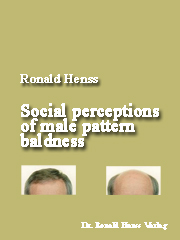
Male pattern baldness
Ronald Henss
Social perceptions of male pattern baldness
A Review
Dr. Ronald Henss Verlag
Vollständiger Nachdruck des Forschungsartikels
Ronald Henss: Social Perceptions of Male Pattern Baldness. A Review. Dermatology + Psychosomatics, 2001, 2, 63-71
Summary The paper presents a review of the empirical literature on strangers’ perceptions of male pattern baldness (androgenetic alopecia). It also discusses some socio-cultural aspects of hair in general, and hair loss in particular.
Key Words Male pattern baldness, androgenetic alopecia, social perceptions, face perception, personality judgments, socio-cultural aspects of hair and hair loss
Zusammenfassung Die vorliegende Arbeit gibt einen Überblick über empirische Untersuchungen zur Wirkung des männlichen Haarausfalls (androgenetische Alopezie) aus der Perspektive des Beobachters. Darüber hinaus werden sozio-kulturelle Aspekte des Haares und des Haarausfalls beleuchtet.
Schlüsselwörter Haarausfall, Glatze, androgenetische Alopezie, Personenbeurteilung, Gesichterbeurteilung, Persönlichkeitseindruck, sozio-kulturelle Aspekte des Haares
Introduction. Focus on male pattern baldness.
In 1967 the British zoologist Desmond Morris published his best-selling book “The Naked Ape” [35]. This title draws special attention to one of the most conspicuous features of human appearance: the relative hairlessness of our bodies. Strictly speaking, we are not really naked. Complete hairlessness is to be found in only a few areas like the lips, the palm of our hands, the soles of the feet, the nipples and some parts of the genitals. The impression of nakedness derives from the fact that on most parts of our bodies our hairs are so fine and short that they are hardly visible, at least from some distance. On the other hand, however, there are some special areas of dense hair that stand in stark contrast to the apparently hairless regions. In fact, it is the characteristic patchy distribution that grabs our attention; and the focus is on those regions that are densely covered with hair, particularly the facial hair in males and the scalp hair in both sexes.
From a strictly biological-medical point of view, hair is not a necessary prerequisite to human survival. On the other hand, however, there can be no doubt that hair is extremely important with regard to our social and psychological experiences. Hair is much more than meets the eye; and evidence abounds that humans are and always have been obsessed with hair.
Because hair is of utmost importance, so is its loss. The most common form of hair loss is male pattern baldness (androgenetic alopecia) which affects a large part of the male population. Although there can be no doubt that male pattern baldness is of great social and psychological significance, there exists little empirical study on its psychological impact. The present paper tries to review the extant literature with regard to a specific aspect, namely social perceptions of hair loss. This is indeed an important topic: after all, hair loss would be an inconsequential affair if our perceptions of others and ourselves would not be influenced by the amount of cranial hair in the first place. Before turning to our main topic, we briefly look at some socio-cultural aspects of hair in general and hair loss in particular.
The importance of hair, past and present.
Humans are preoccupied with hair – and the lack of it. Our preoccupation with hair gave rise to a multi-billion dollar industry. Moreover, millions of people earn their livings in an occupation devoted to hair care. A significant portion of our daily time budget is allocated to hair care and grooming. For some people, particularly women, this may accumulate to many months or even years. Although hair is certainly more important to females, it is also of great concern to males.
For the “stronger sex” the apprehension of hair loss is the focus of interest. In Caucasians, the most common form of hair loss, male pattern baldness, affects approximately one half of the adult male population. Thus, some degree of hair loss is considered normal in adult males [14, 15, 38]. Recently, a large-scale survey was conducted on a representative sample of 1717 men (18-40 years of age) from France, Germany, Italy, and the United Kingdom [18]. 53.5 percent of the participants reported that they had a full head of hair. Thus, 46.5% experienced at least some degree of hair loss. 8.7 per cent had more than “moderate” hair loss, 0.6% reported they were bald. Of course, hair loss increased significantly with increasing age, and the prevalence of more mature states of baldness would steeply rise in an older sample.
…
The complete review is available as an eBook.
…
***



 Veröffentlicht von Ronald
Veröffentlicht von Ronald 
 Abenteuer im FrisiersalonHaarige Kurzgeschichten
Abenteuer im FrisiersalonHaarige Kurzgeschichten